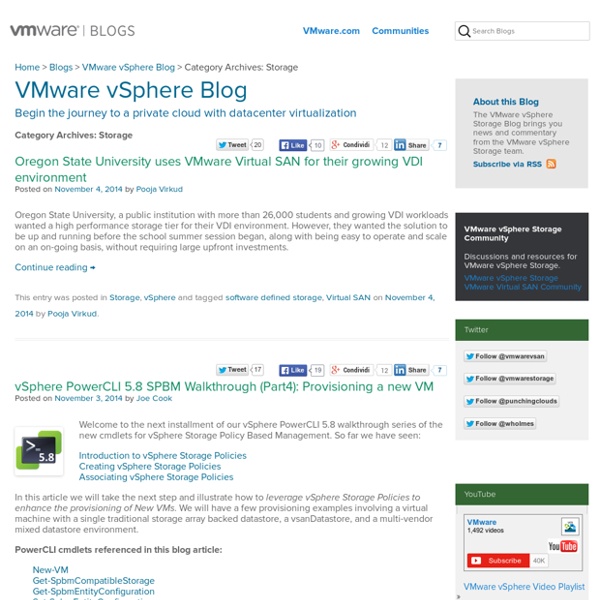VMware vSphere Storage Appliance (VSA) for Shared Storage
End of Availability VMware is announcing the End of Availability of all vSphere Storage Appliance versions, effective April 1, 2014. After this date you will no longer be able to purchase this product. All support and maintenance for vSphere Storage Appliance 5.5 will be unaffected and will continue to follow the Enterprise Infrastructure Support Policy. The End of General Support life date for customers with vSphere Storage Appliance 5.5 remains September 19, 2018. Support contracts can be renewed beyond End of Availbaility until End of General Support. Customers interested in moving to a new VMware software-defined storage solution may elect to upgrade to VMware Virtual SAN.
Review: VMware Virtual SAN turns storage inside-out | InfoWorld
Convergence of compute and storage is all the rage in the virtualization market these days. You see it in Microsoft's Windows Server 2012 R2 with Hyper-V and Storage Spaces. You see it in third-party platforms such as Nutanix. And you see it in VMware's vSphere flagship with the addition of Virtual SAN, a new capability built into the ESXi hypervisor that turns the direct-attached storage in vSphere cluster nodes into highly available, high-performance shared storage. The goals behind Virtual SAN, or VSAN, are both to lower overall storage costs and to eliminate the I/O latencies associated with networked storage. [ Virtualization showdown: Microsoft Hyper-V 2012 vs. VSAN requires a minimum of three vSphere nodes to form a clustered data store. VSAN, at least in its initial release, targets a short list of use cases. For this review, I was provided with hardware from Supermicro and Lenovo.
VMware storage: SAN configuration basics
VMware storage entails more than simply mapping a logical unit number (LUN) to a physical server. VMware’s vSphere enables system administrators to create multiple virtual servers on a single physical server chassis. The underlying hypervisor, vSphere ESXi, can use both internal and external storage devices for guest virtual machines. In this article we will discuss the basics of using storage area network (SAN) storage on vSphere and the factors administrators should consider when planning a shared SAN storage deployment. VMware storage: SAN basics vSphere supports internally-connected disks that include JBODs, hardware RAID arrays, solid-state disks and PCIe SSD cards. SAN storage, however, provides a shared, highly available and resilient storage platform that can scale to a multi-server deployment. It is possible to use NAS and SAN-based storage products with vSphere, but in this article we will consider only SAN, or block-based devices. VMware file system and datastores
What kind of storage do people actually use for VMware ESX servers?
VMware vSphere Best Practices - VMwaremine - Mine of knowledge about virtualization
VMware tools for nested ESXi If you have nested ESXi running on your homelab environment this is something which you should look at. VMware tools for nested ESXi – very cool flings by VMware labs it does work like on any other guest operating system (Linux, Windows). read more OpenSSL heartbleed bug – VMware products Most probably you are aware about recent finding by The bug was independently discovered by security firm Codenomicon and a Google Security engineer. Sponsor News 04/2014 vCAC 6.0 most annoying installation error During my POC on vCAC I had to struggle with different type of issues but he most annoying one was during IaaS component installation. vCO workflow – change vCPU count Recently I started to develop\build my own vCenter Orchestrator workflows. 2014 top VMware & virtualization blog voting results are out vCAC 6 series – Part 11 – Create Blueprint vSphere 5.5 U1 released with vSAN 1.0 support vCAC 6 series – Part 10 – Prepare for provisioning vSAN 1.0 Announcement
Pure Storage Solutions- Super-Charging Your Application Performance- Vmware Server Consolidation
Whether you’re a one-man do-it-all shop or a large enterprise with dedicated storage and VI admin teams, confusion always abounds when trying to manage the storage under VMware. Pure Storage’s vSphere Web Client plugin enables complete management of storage within VMware: automatically create, expand or shrink datastores without worrying about LUNs, see array-side capacity and performance of each datastore, and understand real storage usage through deduplication… all from a single web-based console. Block Storage that’s invisible under VMware No Configuration When all you want is a working datastore, why do you need to have a PhD in storage management to do the job? No Misalignment 512byte virtualization = always aligned Pure Storage natively virtualizes storage at the 512-byte block size, meaning that whatever VMDK and host OS/FS/application alignment you pick, you’ll always get the same consistent performance. Read more about how Pure Storage makes VM alignment irrelevant ›
VMware virtual servers offer advanced shared storage options
Citrix Systems Inc., Microsoft Corp. and VMware Inc. all present IT shops with a variety of options to provision and manage the shared storage systems that are linked to their virtual server technology. Not surprisingly, VMware, the vendor with the most mature product in the market, offers the most advanced support for block- and file-based networked storage alternatives and makes available application programming interfaces (APIs) data storage vendors can use to ensure their systems will work smoothly with its virtual server software, noted Marc Staimer, president at Dragon Slayer Consulting in Beaverton, Ore. In this podcast interview, Staimer outlines VMware virtual servers, what VMware has done to improve the way its products work with storage, contrasts where Microsoft Hyper-V and Citrix XenServer stand in comparison, and offers up advice on choosing the right data storage option for your virtual server environment. Listen to the VMware virtual servers Q&A. Staimer: Sure.



